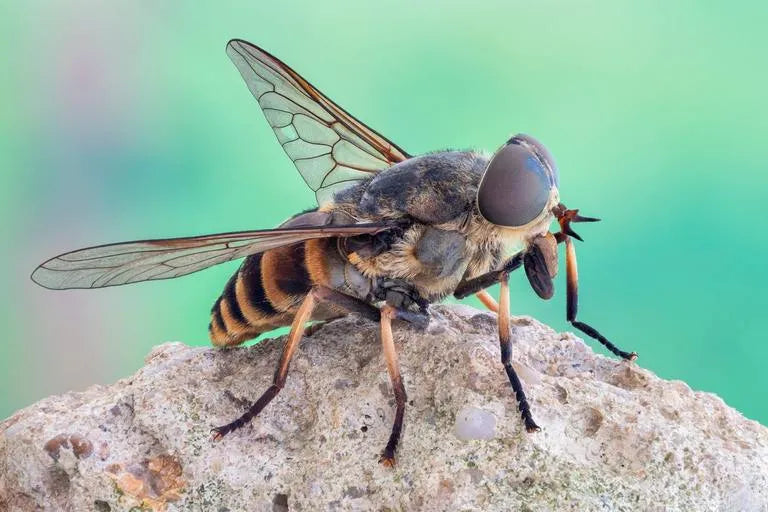
Everything You Need to Know About Horsefly Bites
Share
Horseflies might look like oversized houseflies, but don’t be fooled their bites pack a punch. Unlike most insects, horseflies slice the skin to feed, leaving behind painful wounds that can take days to heal. Whether you’ve just been bitten or you’re trying to avoid it, this guide covers everything you need to know.
What Is a Horsefly Bite?
A horsefly bite is a skin wound caused by a female horsefly while attempting to feed on blood. Their powerful mouthparts slice the skin rather than pierce it, which makes the bite more painful and increases the risk of infection.
Only female horseflies bite, and they need the protein in blood to produce eggs. The male horseflies are harmless and feed only on nectar.
What Does a Horsefly Bite Look Like?
Horsefly bites are usually:
-
Large, red, and swollen
-
Painful and tender to the touch
-
Sometimes bleeding or oozing
-
Itchy or hot around the area
-
Blistered in severe cases
You might notice the bite immediately due to the pain, and it typically becomes more swollen and inflamed over time.
What Do Horseflies Look Like?
Horseflies are easy to identify if you know what to look for:
-
Size: 0.5 to 1 inch (13–25 mm)
-
Color: Gray, black, or brown
-
Eyes: Large, sometimes iridescent or brightly colored
-
Wings: Clear or dark-tinted, often resting flat on the body
-
Body shape: Stocky and robust, similar to a large housefly
They are strong fliers and are often seen buzzing near livestock, water sources, or damp wooded areas.
How Common Are Horsefly Bites?
Horsefly bites are fairly common in:
-
Rural or agricultural areas
-
Near water such as lakes, rivers, and marshes
-
During summer and humid weather
-
Places with livestock or horses
Outdoor workers, hikers, campers, and farmers are more likely to experience horsefly bites due to extended exposure.
Symptoms and Causes
Symptoms of a Horsefly Bite:
-
Intense stinging pain
-
Swelling and redness
-
Warmth and itching
-
Blistering or skin discoloration
-
Occasional dizziness or allergic response
Causes of Bites:
Horseflies are attracted to:
-
Body heat
-
Carbon dioxide from breath
-
Moisture and sweat
-
Movement and dark clothing
They bite to obtain a blood meal, especially when preparing to lay eggs.
How Long Do Horsefly Bites Last?
-
Mild bites: 1–3 days with basic care
-
Moderate reactions: Up to a week, with swelling and itching
-
Infected or severe bites: 1–2 weeks or more, may require medical attention
Healing time depends on your skin sensitivity, bite location, and whether the wound becomes infected.
How to Treat a Horsefly Bite
At-Home Treatment:
-
Clean the wound with soap and warm water
-
Apply a cold compress to reduce swelling
-
Use antihistamine cream or hydrocortisone for itching
-
Take oral antihistamines like diphenhydramine (Benadryl) if needed
-
Avoid scratching to prevent infection
Natural Remedies:
- Aloe vera gel (soothing and anti-inflammatory)
- Witch hazel (astringent to reduce swelling)
- Baking soda paste (helps with itching)
When to See a Doctor
Seek medical attention if you experience:
-
Signs of infection (pus, increased redness, fever)
-
An allergic reaction (hives, difficulty breathing, dizziness)
-
Bite near the eyes or lips
-
Swelling that spreads rapidly
-
Symptoms that don’t improve within a few days
Can Horsefly Bites Make You Sick?
Most bites are harmless but painful. However, horseflies can occasionally transmit bacteria, leading to secondary infections. In rare cases, they may spread diseases to animals, but transmission to humans is very uncommon.
How to Prevent Horsefly Bites
Personal Protection:
-
Wear light-colored, long-sleeved clothing
-
Use insect repellent from DRAGONFLY GUARD
-
Avoid walking near water or livestock during peak times (midday)
-
Stay in screened areas or use fans when outdoors
Environmental Control:
-
Avoid standing water
-
Keep livestock areas clean
-
Install screens or insect traps
-
Wear protective clothing when working outdoors
Are Horsefly Bites Dangerous?
While they are not usually dangerous, the bites are:
-
Painful
-
Easily infected
-
A risk for those with allergies or skin sensitivity
In rare cases, severe allergic reactions can occur, and in animals, repeated bites can cause stress or blood loss.
Do Horseflies Bite Animals Too?
Yes! Horseflies are a major pest for:
-
Horses
-
Cattle
-
Dogs and other pets
Bites can cause irritation, bleeding, and secondary infections in animals. Protective sprays, mesh masks, and stabling animals during peak fly hours can help.
Fun (and Not-So-Fun) Facts About Horseflies
-
Horseflies can fly up to 25 mph one of the fastest flying insects.
-
Their eyes can detect movement from a long distance, making them difficult to swat.
-
Some species are attracted to shiny surfaces and dark colors—so avoid black workout gear near a lake!
Final Thoughts
Horseflies are aggressive biters that can leave behind nasty wounds. While their bites aren’t typically dangerous, they are unpleasant and can lead to complications if left untreated. The best way to deal with them is prevention—so next time you're heading outdoors near water or animals, protect yourself and be aware of their presence.
